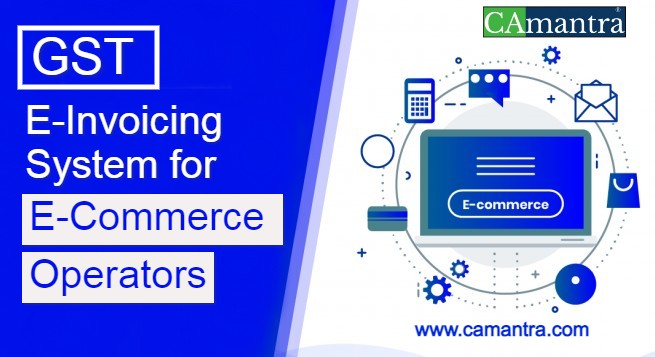E-Invoicing is also known as electronic invoicing’ creates a system through which B2B invoices are electronically authenticated by GST Network for further use. Under the e-invoicing system, an identification no. will be issued against each invoice by the IRP (Invoice Registration Portal) to be managed by the GSTN (GST Network).
The first IRP was launched by the NIC (National Informatics Centre) at the web address einvoice1.gst.gov.in. All information related with invoices will be transferred from this portal to the GST portal and e-way bill portal in real-time. Thus, it will wipe out the need for manual data entry while filing GSTR-1 return as well as generation of part-A of the e-way bills, as the information is passed directly by the IRP to GST portal.
The electronic -invoicing system is also available for the E-Commerce Operators to report the invoices to the IRP (Invoice Registration portal), generated by E-Commerce Operators on behalf of the suppliers. The electronic invoicing system identifies the e-Commerce operators based on the basis of type of taxpayer in the GST registration details. The taxpayer having the type as ‘Tax Collected at Source’ (TCS) will be enabled for reporting invoices on the e-invoicing system as e-Commerce Operator.
E-commerce transactions can be reported by the E-commerce operators with “EcmGstin” attribute as their GSTINs. It means, that apart from specifying the Seller GSTIN in the payload, it is essential to specify the e-Commerce operator GSTIN in the “EcmGstin” attribute of the schema by e-Commerce Operator when he/she logs in using his/her user credentials.
E-Invoice APIs available for E-Commerce Operators:-
- Generate IRN (for self or on behalf of suppliers)
- Cancel IRN (applicable to only for those IRNs, generated by e-Commerce operator)
- Generate E-Waybill
- Cancel E-waybill (applicable to only for those IRNs generated by e-Commerce operator)
- Get IRN (applicable to only for those IRNs, generated by e-Commerce operator)
Operators of e-commerce are allowed to generate IRN on behalf of a supplier. It is mandatory that the e-commerce platform should essentially be registered as e-commerce operator under GST. As per the latest update on the GST Portal, E-Commerce Operators have been enabled to register & test the APIs on the sandbox system.
Services provided by E-commerce come under Reverse Charge Mechanism (RCM). In order to know if these service invoices need IRN or not turnover of the e-commerce operator is important. The transactions made via e-commerce platform are normal supplies done by suppliers and thus in order to know whether e-invoicing is needed for these or not, knowing supplier’s turnover is important. The entire theory of generating an IRN still remains the same which is for B2C transactions IRN generation is not applicable.
Points to Note:
- E-commerce acts as a market place.
- A supplier who is selling the goods needs to have a turnover which is over INR 500 crore. After that the supplier can generate an e-invoice or the e-commerce platform can generate it for them.
- The e-commerce platform selling their own personal branded goods.
- E-commerce operator has issued invoices to the suppliers who are using their market place.
In case the e-commerce GSTIN is used, the data will be accepted by Invoice Registration Portal and it will also flow to GSTR-1 of the seller.
What is the Procedure for integrating on the Sandbox system?
The following process need to be followed by the e-Commerce operators for integrating on the Sandbox system.
- The Registration module in the sandbox system has an option ‘E-Commerce Operator’
- The e-Commerce Operator may select this option and enter the GSTIN of type ‘TCS’ and get registered in the sandbox portal, by authenticating with OTP sent to the GSTIN registered mobile.
- API credentials like Client-Id, Client-Secret, User-name & Password may be generated.
- On logging into the sandbox tool, there is no need to add the GSTINs.
- The payload to generate the IRN may be prepared and tested in the sandbox tool.
- As described, the payload will contain the Seller and Buyer GSTIN and also the e-Commerce GSTIN along-with other details.
- All other validations and schema and procedure mentioned in the sandbox portal may be followed.
What is the Process for integrating on the Production system?
These steps can be followed by the e-Commerce operators to integrate their ERP systems to the production system of IRP.
- The TCS registered taxpayer will need to register in the Invoice registration web portal (https://einvoice1.gst.gov.in). The taxpayer can get logged-in to the Invoice registration portal.
- Select the API registration, if already registered.
- Submit the application for whitelisting the IPs along with summary test report. Up to 4 Indian Static Internet Protocols (IPs) are allowed.
- On submission of the application, the network team will scrutinize and whitelist the IPs.
- API credentials such as Client-Id, Client-Secret, User-name and Password may be generated.
- Generate the username and password for the other PAN related GSTINs by selecting the above GSTIN.
- Use created credentials, the payload to create the IRN, may be prepared and IRN may be generated.
- As already mentioned, the payload will contain the Seller GSTIN, Buyer GSTIN and also the e-Commerce GSTIN along with other details.

